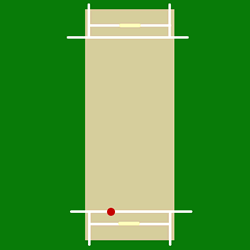Off spin is a type of bowling in the sport of cricket which is bowled by an off spinner, a right-handed spin bowler who uses his or her fingers and/or wrist to spin the ball from a right-handed batsman's off side to the leg side (that is, towards the right-handed batsman, or away from a left-handed batsman). This contrasts with leg spin, in which the ball spins from leg to off and which is bowled with a very different action.
A left-handed bowler who bowls with the same action as an off spinner is known as a left-arm orthodox spinner. While the orthodox spinner has the same action as an off-spinner, the ball itself spins in the opposite direction (akin to a right arm leg spinner).
Off spin is generally considered less difficult to play than leg spin, as off breaks typically spin less than leg breaks, and do not generally possess the same loopy, potentially deceptive flight. In addition, off spinners tend to have a smaller repertoire of deliveries to choose from. However, the off spinner often bowls faster and more accurately than a leg spinner, and can therefore deceive the batsman with changes in the pace of the ball.
Notable contemporary off spinners include, Muttiah Muralitharan of Sri Lanka, who has the most wickets in both ODIs and Test matches, Harbhajan Singh of India, Saqlain Mushtaq and Saeed Ajmal of Pakistan and Graeme Swann of England. Saqlain has been credited with the invention of the "doosra", which is bowled with a similar-looking action to the off break but spins the opposite way, just as the leg spinner's googly turns the opposite way from his stock ball. Another common weapon of the off spinner is the arm ball, which does not spin but goes straight on "with the arm". More skilled offspinners also have the topspinner. Aside from these variations in spin, varying the speed, length and flight of the ball are also important for the off spinner.
Although rare now, in the past there were bowlers who used the off-break action who deliberately did not impart any considerable spin on the ball but relied on line and length to frustrate batsmen. They endeavoured to pitch the ball in an area that the batsman was unable to play a scoring shot, even making last moment adjustments to "follow" a batsman should they move within the crease to negate the bowlers tactics. Whilst this is primarily a defensive style, wickets were achieved by forcing a batsman to make a rash stroke or even bowling at the stumps instead of the retreating batsman. Another wicket taking method was to impart more spin on the ball than usual, and surprise the batsman. An exponent of this style of bowling was "Flat" Jack Simmons who played for Lancashire in the 1970s and 1980s. With the advent of limited overs cricket promoting more adventurous batting styles and the use of ever heavier bats this style of bowling has declined, although some off-spinners will still use this tactic when the pitch is offering very little or no turn.
STEP ONE
The middle joints of the index and middle fingers are well spread across the seam. The ball rests against the third finger but the thumb has little involvement.
STEP TWO
Turning the wrist and the index finger generate the spin on the ball, turning the ball in a clockwise direction.
Use your first two fingers to give the ball a good "rip" at the point of delivery.

